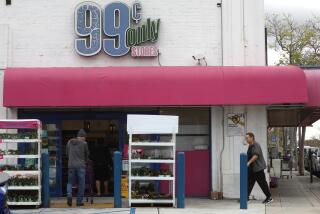Pacific Enterprises Fights Back : Companies: The parent firm of Southern California Gas Co. and Thrifty Corp. faces challenges on economic and legal fronts.
- Share via
After spending months slimming down its far-flung, diversified operations and pumping life into its ailing retail unit, Los Angeles conglomerate Pacific Enterprises ran into a major challenge close to home.
A fiery natural gas explosion tore the roof from a Lakewood home in September, sending a mother and her two children to a hospital burn center in critical condition. Police and gas utility investigators are determining the cause of the explosion and to what extent the Southern California Gas Co.--Pacific Enterprise’s core business and most profitable unit--is responsible.
The incident, which nearly killed 34-year-old Debra J. Bell and her two children, Charles and Kizzie, gives SoCal Gas a public relations black eye and sets it up for possible legal liability, some analysts contend, and it adds to mounting headaches at debt-laden Pacific Enterprises.
Before the explosion, the parent company already had its hands full on several fronts: cost-cutting at the gas company, shedding unprofitable assets at its oil and gas exploration unit and--in its primary project--replacing top management and bolstering sales in its Thrifty Corp. retail business.
As Pacific Enterprises toils away at revamping the company, its stock price continues to fall. On Friday, its share price dropped 50 cents on the New York Stock Exchange to close at $25.25, just above its 1991 low of $24.25. The stock had been as high as $43.375 earlier in the year.
The company’s third-quarter results are due Tuesday, and analyst John Parry, with utilities research firm John S. Herold Inc. of Greenwich, Conn., said the gas company’s earnings should be weak, as is traditional for the third quarter when demand is down. “The retail side is anybody’s guess,” he said.
In May, SoCal Gas announced a belt-tightening campaign to remain competitive--a prospect that is getting increasingly difficult. Electric appliances are becoming more common, and a new gas pipeline begins operation next year, allowing some of the gas utility’s business customers to bypass SoCal Gas completely.
SoCal Gas said in October that it will begin offering and charging an undetermined fee for some services that it did not perform in the past, such as connecting appliances. In May, the gas company said it would close 12 branch payment offices, mainly in suburban areas, outraging many community activists.
SoCal Gas and Pacific Enterprises executives insist that the gas utility budget cuts are not in response to the parent company’s financial woes. But some consumer groups are skeptical, saying gas company cost-saving programs could be setting up a windfall for Pacific Enterprises.
Auditors with the California Public Utilities Commission are investigating the relationship between Pacific Enterprises’ policies and the gas company’s finances. The CPUC will release its findings in late November, said Frank Crua, a commission senior utilities engineer who is coordinating the audit.
At Dallas-based Pacific Enterprises Oil Co., company officials in August announced a curb on drilling at some holdings in Wyoming, Texas, Oklahoma, Louisiana and Alabama. It also slashed its 1992 energy exploration and production budget to $90 million from $200 million.
An undetermined number of job cuts are also on the horizon. Shedding unprofitable assets to reduce debt, the oil company announced in September the sale of its interest in oil and gas reserves in the Dutch North Sea.
Oil and gas aside, the parent company’s most serious challenge lies in its long-running turn-around effort at Thrifty Drug and Discount Stores, the weak link of its more than 1,000-store Thrifty chain.
Thrifty, which Pacific Enterprises brass had hoped would help stabilize the parent company’s profits, posted a $64-million loss last year, the first since its 1986 takeover. The corporation is plagued by weak sales in its 577 Thrifty Drug stores in California. Thrifty took a $100-million charge in 1990 to unload weak drug stores, and Thrifty executives do not predict profits until some time late next year.
Meanwhile, the surprise October resignation of Thrifty Drug President Eve Rich capped months of bloodletting in the ranks of top Thrifty management. Rich, a veteran retail executive, was hired to help give direction to Thrifty’s turnaround efforts.
Analysts and Thrifty executives said the drug store’s problems include a murky idea of who Thrifty’s customers are and tougher competition. Some Thrifty employees criticize the drug store chain for dirty stores with poor service. And in the background lurks a recession that has stuck with retailers like a bad cold.
But it wasn’t always this way. In the mid-1980s, Pacific Enterprises wanted to enter a recession-proof business that would expand its market presence. So it ventured from the highly regulated public utility business to take a walk on the wild side of competitive, unpredictable retailing.
The company paid $887 million for the Los Angeles-based Thrifty chain, surprising many industry observers. Among Thrifty’s advantages are its dominant market share in Southern California, its health-care items that appeal to a graying America and its wide name recognition.
But today, results from the risky retailing venture are forcing the beleaguered parent company to look critically at what its diversification strategy has spawned.
James R. Ukropina, Pacific Enterprises chairman and chief executive, concedes that the business triad of retailing, gas utility and energy exploration offers “no symmetry of opportunities.” Pacific Enterprises, he added, “didn’t purport to come into retailing with retail experience.”
He gets little argument from many of the company’s observers.
Pacific Enterprises “just made a mistake” in 1986, said former Thrifty executive Bernie Fields. Pacific Enterprises “wanted to diversify, which is meaningful to some extent. But beyond that it is dangerous,” he said.
Thrifty Drug has not shielded Pacific Enterprises from the recession, nor helped the parent company stabilize profits. Pacific Enterprises halved its dividend in June, due in large part to weak performance in its retailing unit.
“It’s fair to say Thrifty became less competitive in the late ‘80s,” Ukropina said. The conglomerate’s goal is to “bring Thrifty up to a more competitive level.”
The solution, according to Pacific Enterprises executives, is to put a new face on Thrifty Drug, using new marketing, merchandise and management to attract its new focus of attention: women, who account for 70% of Thrifty’s customers.
For the company, that means “we want to make sure we are not left in the dust,” said William Yingling, Thrifty Corp.’s chairman and chief executive officer.
Customers can expect to see old drug stores take on a new look, with merchandise selected to appeal to “time-poor individuals,” Thrifty’s label for get-it-and-go shoppers.
Gone from most Thriftys are the extensive gardening and automotive sections. In their place are more household items, such as Rubbermaid plastic containers and pots and pans. Thrifty shoppers will see more personal care items and expanded cosmetic sections, with everything from lip gloss to hair brushes.
To gauge customer reaction to the changes it has planned, Thrifty in April opened an “experimental” store in suburban Agoura Hills, which serves as a retail laboratory.
As Thrifty Drug executives decide what flies and what fizzles, shoppers “will see parts, but not all” of the experimental store, said Thrifty Vice President Chris Bement during a tour of the Agoura Hills store.
The well-lit aisles and spacious feel of the experimental store are “like a heaven compared to others,” in the drug store chain, said Jeannette House, who manages the cosmetic department in the Agoura Hills store.
Whatever turnaround the ailing chain executes will take place in a marketplace where “everybody is competing with drug stores, not just other drug stores,” observed David Vaczek, senior editor of the New York-based industry publication Drugstore News.
Pacific Enterprises executives insist that they are bullish on Thrifty’s future. But improvement is not expected to come overnight. Ukropina, who predicts that Thrifty will improve with the economy, said “it could be well into the next year before we see the economy out of the dip.”
Ukropina said the parent company will work with the retailer “for a period of time which gives (Thrifty management) the opportunity for turnaround in a recession. . . . We will give them time well into next year and then review their strategy.”
Fields, along with some analysts, is less sanguine about Thrifty, saying Pacific Enterprises “would love to get rid of it” if someone would make an offer. But most analysts contend that the end result of Pacific Enterprises’ difficult year should be positive.
“Pacific Enterprises is in reasonable financial health,” said Lawrence Crowley, an analyst with the research firm of Rauscher, Pierce Refsnes in Houston. “They don’t have an overly burdened balance sheet. The outcome of the retail operation does put a question mark on their balance sheet . . . (but) it is not life-threatening.”
Where the Money Comes From
Pacific Enterprises’ steady money-maker has been its gas utility. Retailing, however, has been more shaky. Although retailing generates 46% of revenue, it accounts for 7% of the conglomerate’ profits due to changes and losses in operating income. Revenue:
Oil and gas exploration and production: 5%
Retailing: 46%
Utility: 46%
Other: 3%
Profits:
Oil and gas exploration and production: 21%
Retailing: 7%
Utility: 67%
Other: 5%
Source: Standard and Poor Corp.
More to Read
Inside the business of entertainment
The Wide Shot brings you news, analysis and insights on everything from streaming wars to production — and what it all means for the future.
You may occasionally receive promotional content from the Los Angeles Times.










